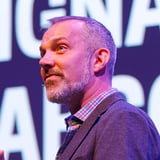Summary
The outcome of designing at scale won't be accessible products unless accessibility practices scale in parallel with design. There are six primary challenges to scaling accessibility: 1) Reliance on human testing which is especially complicated for large/dynamic products. 2) SaaS/Native app "release whenever you want" timelines. 3) Third party code/content managers. 4) Achieving "substantive WCAG conformance" 5) Closing the feedback loop by getting defects/feature requests from people with disabilities into the backlog. 6) Shifting the focus to an accessible experience, not just an accessible product.
Key Insights
-
•
Accessibility encompasses both visible and invisible disabilities, affecting roughly 30% of users via permanent, temporary, or situational impairments.
-
•
Assistive technologies communicate bidirectionally with software, requiring products to support this interaction cleanly to be accessible.
-
•
WCAG standards are the international source of truth for accessibility, with version 2.1 AA widely mandated and 3.0 on the horizon.
-
•
Automated tools catch about 30% of accessibility issues, machine learning tools currently only about 4%, leaving over half to human validation.
-
•
Making a product accessible initially is straightforward with resources and people; maintaining accessibility over time is far more complex and process-driven.
-
•
Scaling accessibility in cloud and continuous integration environments is challenging due to rapid, frequent software releases.
-
•
Integrating accessibility from the beginning into design, development, and definition of done prevents costly retrofitting later.
-
•
Organizational culture changes including executive buy-in, centralized resources, and accessibility champions are essential for scaling.
-
•
Hiring and retaining employees with disabilities and ensuring all workplace tools and events are accessible fosters inclusion and eases product accessibility efforts.
-
•
Accessibility defects should be treated like any other critical bugs and prioritized accordingly to ensure timely remediation.
Notable Quotes
"Accessibility isn’t just about visible disabilities; it’s about invisible disabilities and situational impairments too."
"Either you need accessibility now or you will need accessibility in the future."
"Assistive technology has to communicate with the destination, that’s your website or product."
"You’re not supposed to sell to the US public sector unless you’re WCAG 2.0 AA compliant."
"Getting something accessible is a straight line; keeping something accessible requires process change."
"Keeping something cloud-based accessible is the most complicated because of hundreds of releases per day in continuous integration."
"Accessibility at scale can put you into the VUCA world – volatile, uncertain, complex, ambiguous."
"You want to catch accessibility defects early through automated testing in your CI/CD pipeline, what we call shifting left."
"If you’re rewarding designers for delivering on time, great, but if you reward them for delivering accessible products on time, you’ll get better results."
"Accessibility defects are bugs. If it’s a P1 blocking bug for an accessibility issue, treat it like any other P1 bug."
Or choose a question:
















More Videos

"High quality personal connections mean you can engage on a level playing field with serious professionals."
Marc Fonteijn Ru ButlerIncrease your confidence, influence, and impact (through a Professional Community)
December 3, 2024

"We emphasize collaboration, not individual work, to build teams and collective knowledge."
Victor M. GonzalezPracticing Learners and Learning Practitioners
March 10, 2021

"You don’t need to be an expert in accessibility before doing user research with people with disabilities."
Elana Chapman Li Wen Huang Divyen Sanganee Annabel WeinerGetting started with accessibility research
February 20, 2025

"Consumers are clamoring for payment to be embedded in their devices because payment can be a pain point in digital commerce."
Karen PascoeDeveloping Experience Teams and Talent in the Enterprise
June 8, 2016

"Start with the problem, not the solution when partnering with engineers."
Dawn ResselFull-Stack User Experiences: A Marriage of Design and Technology
June 9, 2016

"Human-centered design is not just about your end users, it’s about the humans in your team."
Gretchen AndersonScaling the Human Center
June 8, 2017

"Giving parents something meaningful to do during sessions helps keep them engaged and supportive."
Mila Kuznetsova Lucy DentonHow Lessons Learned from Our Youngest Users Can Help Us Evolve our Practices
March 9, 2022

"Diverse teams create diverse products because we each only understand our own needs."
Sam ProulxAccessibility: An Opportunity to Innovate
November 16, 2022

"Should you separate design from code? In some multi-framework environments, yes, it makes sense."
Nathan CurtisDesign Systems for Us: How Many One-Source(s)-of-Truth Are Enough?
January 17, 2019
















